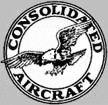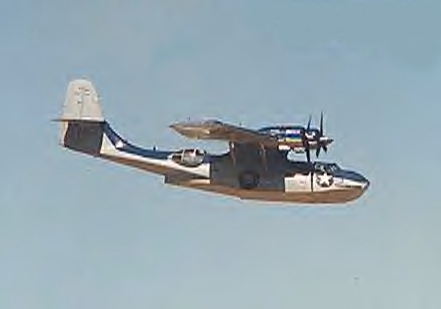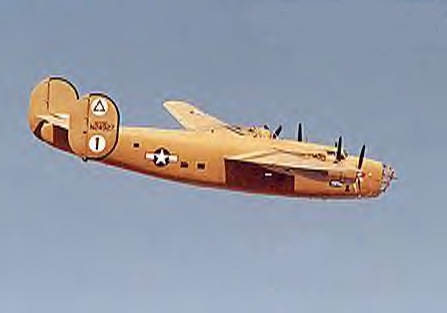

Consolidated Aircraft
The
Consolidated Aircraft Corporation was founded by Reuben H. Fleet in
1923 in Buffalo, New York.
Consolidated's first aircraft was a trainer based on a
Dayton-Wright design. This first aircraft sold well to the Army as the
PT-1 and the Navy as the NY-1.
Consolidated was well known for its flying boats of the
1920's and 30's culminating in the PBY Catalina and PB2Y Coronado.
Perhaps the most famous Consolidated aircraft was the B-24 Liberator.


Consolidated Aircraft was acquired by Vultee in 1943
forming Consolidated-Vultee Aircraft--abbreviated Convair.
1923: Rueben H. Fleet, manager of Gallaudet,
forms Consolidated Aircraft Corp. by merging Gallaudet with Dayton-Wright.
1928: Acquires Thomas-Morse
1929: Acquires Fleet Aircraft
1935: Moves to San Diego, California
1940: Takes over Hall Aluminum Aircraft
1943: Merges with Vultee to form
Consolidated-Vultee Aircraft (Convair).
Consolidated Vultee
Aircraft Corporation
Consolidated Vultee
Aircraft Corporation was formed in March 1943 with the merger of
Consolidated Aircraft and Vultee Aircraft corporations. Both companies had
been operating independently for more than a year under the umbrella of
the Aviation Corporation (AVCO). Soon the merged company would be known as
Convair.
Consolidated Aircraft was
formed on May 29, 1923, by Major Reuben Fleet. It was one of the first
aircraft firms to be formed by acquiring assets of existing firms. Fleet
took over Gallaudet Aircraft's business and acquired the rights to
Dayton-Wright Company designs from General Motors, which had left the
aviation business.
Fleet had served as a
pilot in the U.S. Army and had organized the Army airmail service in 1918.
He was an excellent salesman and used his Army Air Service contacts to get
business. The Army and Navy, as well as overseas militaries, ordered his
PT-1 and NY trainers. More than 200 of various models were built, which
remained popular into the mid 1930s.
In 1927, the U.S. Congress
targeted Consolidated for earning "excess profits" of $300,000 on trainer
production. But, resourcefully, rather than refund the money, Consolidated
supplied an additional 50 trainers to the Army for one dollar each. This
pleased the Army because it got the planes while any refund would have
gone into the Treasury.
Consolidated went public
in early 1929, and Fleet organized Fleet Aircraft, Inc., a subsidiary of
Consolidated, to manufacture the Fleet biplane trainer for the civilian
market. Fleet acquired Thomas-Morse in August 1929. Another successful
plane was the Consolidated XPY-1 Commodore, a large monoplane flying boat.
It could carry 20 passengers in three spacious cabins for a distance of
about 1,000 miles (1,600 kilometres). Consolidated also built the
Fleetster, an eight-seat all-metal transport with a NACA cowling, one of
the most popular light civil aircraft, in 1932.
In late 1935, because of
problems testing the flying boats in frigid Buffalo, New York, weather,
Fleet moved to San Diego, California, and continued to develop flying
boats for the Navy and the P-30 pursuit plane for the Army. Chief engineer
I.M. Laddon directed the development of the XP3Y-1, the predecessor to the
famous wartime PBY Catalina, which flew later that year. In 1937, the Navy
ordered 60 P3Y-1s, later the PBY-1, for $22 million, the largest single
military aircraft order since World War I. The larger XPB2Y-1 Coronado
flying boat, first flown in December 1937, saw limited service in the war.
As the country geared up
for war, the Air Corps approached Fleet in 1939 about becoming a second
manufacturer for the Boeing B-17 bomber. Fleet instead proposed to develop
the B-24, a new, more advanced bomber. In March 1939, Consolidated
received a contract for a prototype B-24. The B-24, while similar to the
B-17 in overall dimensions and power, was quite different. It had a
high-aspect-ratio cantilevered wing, a fuselage with a large bomb-carrying
capacity, and for the first time on a large aircraft, tricycle landing
gear. Consolidated developed the B-24 in nine months and it first flew in
late December 1939. It became Consolidated's major product and would prove
to be one of the outstanding aircraft of World War II.
In late 1941, under
increasing pressure to sell his interest in Consolidated and retire, Fleet
sold his 34 percent stock holding to Vultee Aircraft, an AVCO company, for
$10 million, ending the independent Consolidated Aircraft Corp.
The second predecessor to
Consolidated Vultee was Vultee Aircraft, Inc. Gerard "Jerry" Vultee and
Vince Breese had started Airplane Development Corporation in early 1932
after American Airlines showed great interest in their six-passenger V-1
design. Soon after, Erret Cord bought all 500 shares of stock in the
company and Airplane Development Corporation became a Cord subsidiary.
AVCO then established the Aviation Manufacturing Corporation (AMC) in 1934
through the acquisition of Cord's holdings including Vultee's Airplane
Development Corporation. AMC was liquidated on January 1, 1936 and Vultee
Aircraft Division was formed as an autonomous subsidiary of AVCO. Vultee
acquired the assets of the defunct AMC, including Lycoming and Stinson.
Vultee Aircraft, Inc. was created in November 1939, when Vultee Aircraft
Division of AVCO was reorganized as an independent company.
Meanwhile, Vultee and
Breese had redesigned the V-1 to meet American Airlines' needs and created
the eight-passenger V-1A. American purchased 11 V-1As, but the plane
ultimately failed due to safety concerns about a single-engine plane and
the advent of the twin-engine Douglas DC-2s and DC-3s. Vultee redesigned
the V-1 into the V-11 attack aircraft for the Air Corps, but it too
received few orders.
Unfortunately, before he
could see Vultee become an independent company, Jerry Vultee and his wife
died in a plane crash in the California mountains. Richard Millar
succeeded Vultee, and Vultee Aircraft, Inc. began to develop advanced
military designs. Its major production programs, however, were the BT-13
Valiant trainer and V-72 Vengeance, serving as the A-31 and A-35.
On March 17,1943,
Consolidated and Vultee officially merged, creating Consolidated Vultee
Aircraft Corporation, popularly known as Convair. The Vultee management
resigned, and Victor Emanuel of AVCO, who controlled the company, hired
Tom Girdler as chairman, Harry Woodhead as president, and I.M. Laddon as
executive vice president and general manager.
In 1944, the Navy began
developing a surface-to-air missile (SAM), known as Project Bumblebee.
Convair was one of the companies selected to produce the SAMs and in 1953,
began producing the first all-rocket SAM—the Terrier. In the future,
Convair would continue producing SAMs such as the Terrier, Tartar, and the
famous Atlas.
Throughout the war,
Convair had an outstanding production record, delivering more than 28,000
completed aircraft between Pearl Harbour and V-J Day. Production of the
B-24 alone totalled 10,708 planes. Convair produced a total of 2,140 PBY
planes, more than any other flying boat or amphibian, and was famous for
its rescues of aviators in the Pacific.
After the war, Convair had
a development contract for the first, big new bomber after the war, the
B-36. The first intercontinental bomber, it could carry up to 72,000
pounds (32,659 kilograms) of bombs and 16 crewmembers, had two pressurized
compartments, and could fly 12,000-mile (19,312-kilometer) missions. The
first flight of the B-36A was on August 28, 1947. It was ordered into
production in 1948 at the Fort Worth, Texas, plant, and through 1954, a
total of 285 B-36s were built.
However, it soon became
clear that Convair was having problems. Its CV-240 airliner, developed
from the Model 110, began service in June 1948 but experienced problems.
Further, production of the B-36 was not proceeding smoothly and while the
B-46 four-engine bomber appeared to be a successful design, the military
ordered the North American B-45 instead.
On April 12, 1946, Reuben
Fleet resigned from Convair, ending his involvement with the company he
built. Victor Emanuel eventually brought stability to Convair, but by that
time he was ready to dispose of the company and leave the industry.
Convair interested Floyd B. Odlum, a multimillionaire aviation investor,
and in 1946 through his Atlas Corporation, Odlum began buying Avco
Manufacturing Corporation (the renamed Aviation Corporation) stock. On
September 4, 1947, after negotiating with Emanuel, Odlum swapped all of
his Avco stock for all of Convair's aviation operations in San Diego, Fort
Worth, and Detroit. Odlum's Atlas Corporation took control of Convair in
November 1947.
Odlum replaced Harry
Woodhead, in 1948 with La Motte T. Cohu. Odlum returned Convair to
profitability in 1949, benefiting from a buildup in military orders.
Under Odlum, Convair
established leadership in delta-wing design. In September 1948, the XF-92A
delta design first flew. It was intended as an Air Force interceptor but
was used only for research. However, because of its design, in 1950
Convair received a contract for the advanced supersonic F-102 Delta
Dagger. Another delta wing development was the XF2Y-1 Sea Dart for the
Navy. First flown in April 1953, it was an experimental amphibious fighter
with retractable "hydro-skis" that extended for takeoff and landing.
Convair used the CV-240 as
a basis for the T-29 trainer and it enjoyed a nice production run. The
redesigned civilian CV-340 first flew in October 1951 and became a
bestseller.
Even with its success,
Odlum wanted to merge Convair or sell it completely. He met with numerous
people including the eventual acquirer, John Jay Hopkins of Electric Boat.
Discussions in 1951 led to their 1953 agreement. The two firms officially
merged on April 29, 1954, with the renamed Electric Boat, General
Dynamics, creating its Convair Division. As well as its aircraft
manufacturing, the Convair Division would be a major participant to the
American space program.
|
